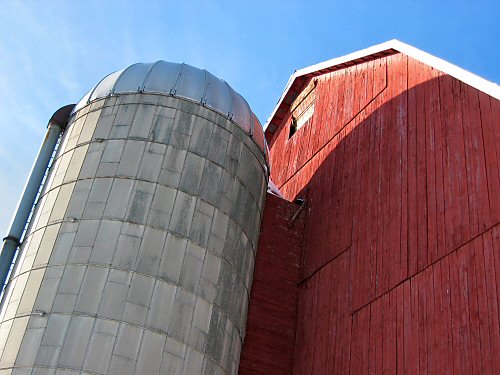
We haven’t had much sun lately, but it came out for the top half of the day today. What a difference sunshine makes, if you have any choice at all, you certainly can’t stay indoors (especially in front of a computer!). In my slow and steady exploration of all the many parts of the barn not used in tiny farming, I snapped a shot of the silo at the south end, looking quite imposing in the bright light, kinda industrial, and still in good shape. This is an old concrete silo, about 40′ (12m) high, used mainly for silage (partially fermented crops used for livestock feed). It was last filled around 15 years ago, when this was a full-fledged dairy operation. Field corn was chopped up and blown up the tube on the left. Packed in, the corn would start to ferment, which helps preserve it for winter feed. Cows apparently love silage! At times, the silo was also used to store dried corn (the kernels) for feed. Hmmm, wonder how to reuse a silo…




Mike, I have been avidly following your blog for some months now, and just wanted to let you know how much I enjoy it! I love the little nuggets about the farm that you share every day. Someday when I have a little more time I will visit your forum, as it is a wonderful idea. But for now, just wanted to say thank you for the inspiration!
Way to go on the reuse idea! Haha.
Great picture with the contrasts…
Katie at GardenPunks
Melinda: Thanks! Your blog looks like it has lots of good reading. So far, I read your fleeing from the city intro and spent some time looking at the pictures. What am I going to do about blog reading when things get busy?
Mike,
I have been following your blog for a while now and finnaly feel like I have something to add.
One of the more interesting uses for old farm silos I have come across is as observatories for amateur astronomers.
http://ottawa.rasc.ca/articles/meier_rolf/rmeier_obs/observatory.html
Also have seen them converted into living space. Some folks recomend them as hot tub enclosures.
What have you done with your silo?
And i just had to include this link as it has some awesome new silo uses,
http://www.lancasterdomes.com/photos.htm
Hope you can use some of these suggestions and don’t forget to keep taking pictures.
Rick
I don’t know what you can do with an old silo like that but it sure does look good on your farm. Really adds character especially knowing it has been there for some time. Looking forward to see your garden coming into bloom.
Kramer
Rick: Thanks! All of those links were great. There’s so much you can do on a farm, especially an “old-style” family farm with barn and outbuildings. As you usual, it’s a case of so much to do, so little time… My next step on the silo is to see what it’s like inside… (BTW, I turned one your URLs into a link—”What have you done with your silo?”—’cause it was so long as an URL it was sticking out… I don’t usually touch people’s comments, hope you don’t mind!)
Jason Kramer: I checked out your blog. It’s really good, I was reading for half an hour! I really enjoy the detailed description of what’s going on. Even as I’m learning about small-scale veggie growing, the livestock side is on my mind. I particularly like the idea of rotating grazing sections for the cattle. It looks like you just started your blog, hope you keep up the detail through the year!! (BTW, on the whole, I’m pretty sure people in Canada like bacon, and pork chops, too! :)
Nice photo! And nice view for you even if you don’t get to use the silo.
We make “grass” silage on our farm but don’t have anything like that big silo – these days the grass gets bailed and wrapped in plastic (like big plastic balls) then left to ferment for a few months.
Your comment about cows loving silage is true – despite the distinctive smell they love to gobble it up!
To answer your question…there is not much you can do with that silo, at least not safely with a silo of that design. Very few are left as any that were extensively used have mostly toppled over.
Its called a concrete stave silo and the design was flawed from the get-go. In a nut shell, a 3 inch wide plank of concrete was used on end and then wrapped together with the wire bands. Its like stacking playing cards on end, and as long as no one sneezes it will stand up, but if something shifts, like silage in the middle of the night after being blown in, it will collapse.
Ours was a little higher at 65 feet, and it lasted from 1979 to 1990 before it finally collapsed. It never took out a cow, but it took out a new blower and a 120 hp tractor when it let go, making us scramble at 6 AM to put the 600 tons of feed into a bunker silo before it spoiled.
Upon trying to find out why it fell, it was noted that most do. It was a faulty design and the company that put them up is no longer in business. Enjoy its asthetic beauty, but be careful, they are not safe.
Nice picture of a concrete silo and barn.